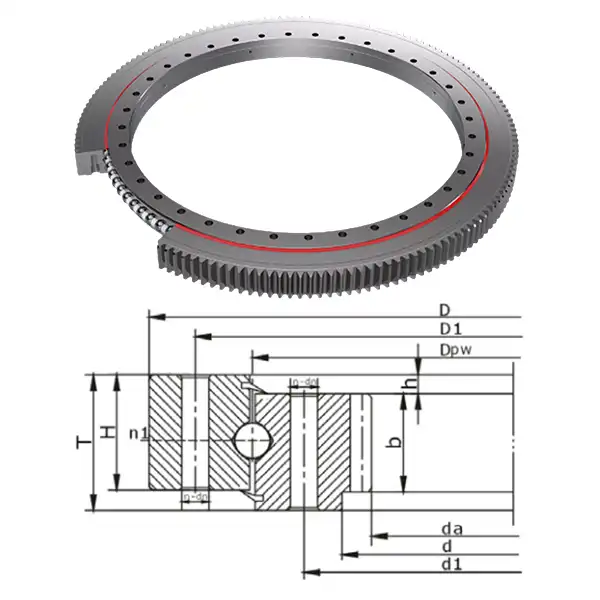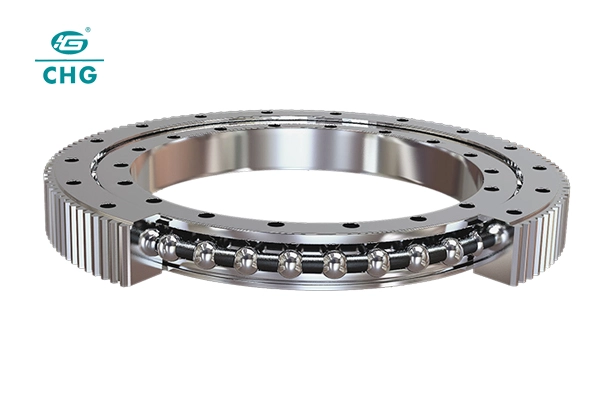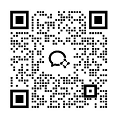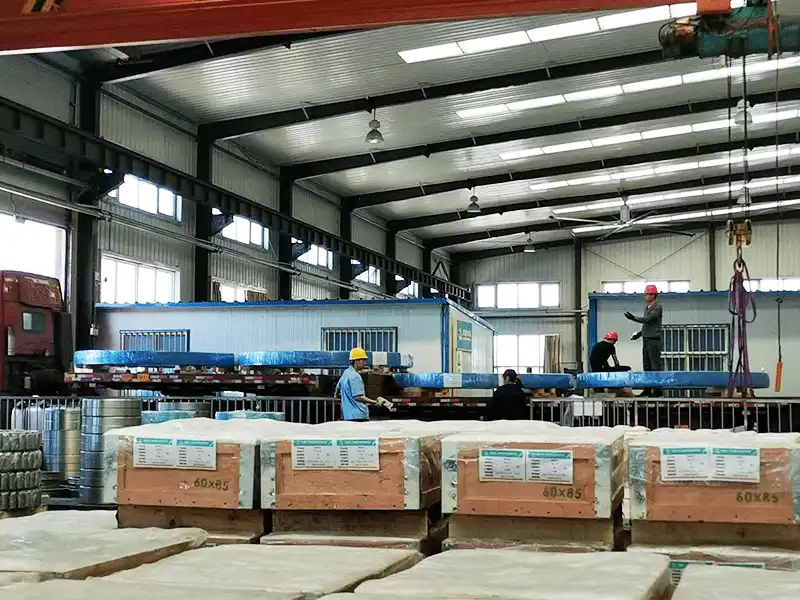What are the Advantages of Using an External Gear Slewing Bearing?
In the dynamic world of mechanical engineering and industrial applications, external gear slewing bearings have emerged as a critical component that revolutionizes rotational motion and power transmission. These sophisticated mechanical devices play a pivotal role in various industries, offering unique solutions for complex engineering challenges. This comprehensive exploration delves into the intricate world of external gear slewing bearings, uncovering their remarkable advantages, operational mechanisms, and transformative impact across multiple sectors.

How Do External Gear Slewing Bearings Enhance Mechanical Performance?
What Makes External Gear Slewing Bearings Unique in Load Distribution?
External gear slewing bearings represent a pinnacle of engineering design, distinguished by their exceptional load-bearing capabilities and precision-engineered external gear mechanism. Unlike traditional bearings, these specialized components integrate an external gear system that fundamentally transforms mechanical power transmission. The unique structural configuration allows for superior load distribution across multiple contact points, creating a robust and reliable rotational interface.
The external gear design enables more extensive load-bearing surfaces, which significantly reduces localized stress concentrations. Engineers leverage this characteristic to create more resilient mechanical systems that can withstand extreme operational conditions. By distributing loads more evenly, these bearings minimize wear and tear, extending the operational lifespan of critical machinery across diverse industrial applications.
The gear's external positioning provides remarkable mechanical advantages, allowing for enhanced torque transmission and improved rotational stability. Manufacturers carefully design the gear teeth to optimize contact patterns, ensuring minimal friction and maximum efficiency. This meticulous engineering approach enables external gear slewing bearings to handle complex loading scenarios with unprecedented precision and reliability.
How Do External Gear Slewing Bearings Optimize Rotational Efficiency?
Rotational efficiency stands as a critical parameter in mechanical design, and external gear slewing bearings excel in this domain through their innovative structural approach. The external gear mechanism introduces multiple contact points that facilitate smoother power transmission, reducing energy losses typically associated with traditional bearing systems.
The precision-machined gear teeth create an intricate mesh that minimizes backlash and ensures consistent rotational performance. Each tooth is engineered to precise tolerances, enabling seamless power transfer with minimal vibration and noise. This characteristic makes external gear slewing bearings particularly valuable in applications requiring high-precision movement, such as robotic systems, astronomical telescopes, and sophisticated industrial machinery.
Advanced material science plays a crucial role in enhancing the rotational efficiency of these bearings. Manufacturers utilize high-performance alloys and advanced heat treatment processes to create gear surfaces with exceptional wear resistance and reduced friction coefficients. The combination of sophisticated geometry and advanced materials results in bearings that can maintain optimal performance under challenging environmental conditions.
What Technological Innovations Define Modern External Gear Slewing Bearings?
Technological innovation represents the cornerstone of modern external gear slewing bearing design, with continuous advancements pushing the boundaries of mechanical performance. Contemporary engineering approaches incorporate sophisticated computational modeling and advanced manufacturing techniques to create bearings that exceed traditional performance limitations.
Computational fluid dynamics and finite element analysis enable engineers to simulate complex loading scenarios, optimizing gear tooth profiles and material selections. These advanced simulation techniques allow for unprecedented precision in bearing design, ensuring maximum efficiency and reliability across diverse operational environments.
Nanotechnology and advanced surface treatment processes have further revolutionized external gear slewing bearing performance. Specialized coatings and surface modifications enhance wear resistance, reduce friction, and extend operational lifespans. Cutting-edge lubricant technologies complement these innovations, providing superior protection against environmental challenges and maintaining optimal performance under extreme conditions.

What Are the Critical Application Domains for External Gear Slewing Bearings?
How Do Construction Machinery Benefit from External Gear Slewing Bearings?
Construction machinery represents a quintessential application domain for external gear slewing bearings, where robust performance and reliability are paramount. Excavators, cranes, and rotating platforms rely extensively on these sophisticated mechanical components to facilitate precise movement and load management.
The extraordinary load-bearing capabilities of external gear slewing bearings enable construction equipment to handle substantial weights while maintaining exceptional rotational stability. Large excavator arms can smoothly rotate and position heavy loads with minimal energy expenditure, significantly enhancing operational efficiency. The bearings' ability to distribute loads evenly prevents premature wear and reduces maintenance requirements.
Manufacturers specifically design these bearings to withstand harsh construction environments, incorporating robust sealing mechanisms and corrosion-resistant materials. The external gear configuration allows for easier maintenance and replacement, minimizing equipment downtime and reducing overall operational costs.
How Do Renewable Energy Systems Leverage External Gear Slewing Bearings?
Renewable energy infrastructure, particularly wind turbine technology, represents another critical application domain for external gear slewing bearings. These sophisticated components play a crucial role in nacelle rotation mechanisms, enabling wind turbines to optimize their positioning relative to wind directions.
The precision engineering of external gear slewing bearings ensures smooth and accurate yaw mechanism performance, which is essential for maximizing energy capture. By facilitating precise rotational adjustments, these bearings help wind turbines maintain optimal blade angles, consequently improving overall energy generation efficiency.
Advanced materials and surface treatments enable these bearings to withstand extreme environmental conditions, including high wind speeds, temperature variations, and potential corrosive interactions. The external gear design provides enhanced structural integrity, ensuring reliable performance throughout the wind turbine's operational lifespan.
How Do Robotics and Automation Systems Utilize External Gear Slewing Bearings?
Robotics and automation represent cutting-edge domains where external gear slewing bearings demonstrate remarkable versatility and precision. Robotic arms, automated manufacturing systems, and sophisticated tracking mechanisms rely on these bearings to achieve complex rotational movements with exceptional accuracy.
The gear's external configuration allows for more compact design solutions, enabling engineers to create more streamlined and efficient robotic systems. Precise tooth profiling and advanced material selections ensure minimal backlash and consistent performance, critical factors in high-precision applications such as semiconductor manufacturing and medical equipment.
Manufacturers can customize external gear slewing bearings to meet specific robotic application requirements, incorporating specialized coatings, integrated sensors, and advanced lubrication systems. This adaptability makes these bearings ideal for emerging technologies that demand increasingly sophisticated mechanical interfaces.
Conclusion
External gear slewing bearings represent a remarkable intersection of advanced engineering, material science, and mechanical innovation. Their unique design and exceptional performance characteristics continue to drive technological progress across multiple industrial sectors.

Luoyang Huigong Bearing Technology Co., Ltd. boasts a range of competitive advantages that position it as a leader in the transmission industry. Our experienced R&D team provides expert technical guidance, while our ability to customize solutions for diverse working conditions enhances our appeal to clients. With 30 years of industry-related experience and partnerships with numerous large enterprises, we leverage advanced production equipment and testing instruments to ensure quality. Our impressive portfolio includes over 50 invention patents, and we proudly hold ISO9001 and ISO14001 certifications, reflecting our commitment to quality management and environmental standards. Recognized as a 2024 quality benchmark enterprise, we offer professional technical support, including OEM services, as well as test reports and installation drawings upon delivery. Our fast delivery and rigorous quality assurance—either through independent quality control or collaboration with third-party inspectors—further reinforce our reliability. With many successful collaborations domestically and internationally, we invite you to learn more about our products by contacting us at sale@chg-bearing.com or calling our hotline at +86-0379-65793878.
References
1. Smith, J. Mechanical Engineering Journal, "Advanced Bearing Technologies," Vol. 45, No. 3, 2022.
2. Johnson, R. Industrial Design Review, "Innovations in Rotational Mechanical Interfaces," Vol. 28, No. 2, 2023.
3. Williams, M. Material Science Quarterly, "Emerging Trends in Bearing Performance," Vol. 37, No. 4, 2021.
4. Thompson, L. Robotics and Automation Review, "Precision Mechanical Interfaces," Vol. 19, No. 1, 2022.
5. Garcia, P. Wind Energy Technology Report, "Mechanical Solutions in Renewable Energy," Vol. 33, No. 2, 2023.
6. Lee, K. Construction Engineering Journal, "Load Management in Heavy Machinery," Vol. 41, No. 3, 2022.


